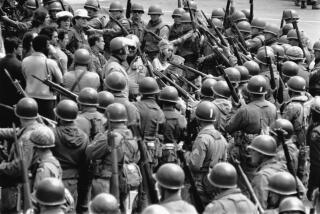A picture of the past
On an autumn day 125 years ago, photographer John Calvin Brewster climbed to the top of a scrubby hill above San Buenaventura Mission and did future historians a big favor.
Pointing a bulky camera, he took a photograph of the pioneer town so precise that researchers still pore over it to glean information about a horse-and-buggy society that was about to undergo dramatic change.
This month, archeologists used the photo to pinpoint the foundations of Ventura County’s first administrative buildings, unearthing its original courthouse, a jail, an outhouse and a mission-era wall.
And that’s just one image. There are hundreds more.
Brewster made portraits not only of the day’s dandies but also of ordinary folks, big events and landscapes, chronicling Ventura’s transformation from sleepy mission town to burgeoning community.
The rarest images were captured on 350 large glass-plate negatives that are stored under the protective eye of research librarians at the Museum of Ventura County in downtown Ventura. Now the fragile collection is being digitally scanned, giving researchers and the public greater access.
Chronicling life in Ventura County from 1874 -- a year after its founding -- until Brewster’s death in 1909, the photos are a treasure trove for researchers, genealogists and history buffs, said librarian Charles Johnson.
“I’ve been looking at this photograph for 18 years and I’m still finding things,” Johnson said of the iconic image of downtown Ventura that Brewster is believed to have taken in 1882.
The photograph told archeologist John Foster where to start digging this month to unearth an outhouse just outside the county’s first courthouse.
Sure enough, the wood-planked pit, 6 feet deep, was still there, said Foster, who is heading the excavation. His team has uncovered an ancient pistol, several empty whiskey bottles and a set of false teeth.
“His work is key to our work,” Foster said, holding photocopies of several Brewster images. “This material makes our work so much easier.”
The digitization is part of a larger plan to make the library’s valuable collection easier to use by the public, Johnson said. Each image is being scanned, indexed and stored as a digital file that can be searched by library visitors.
About two-thirds of the glass plates have been transferred, using a $25,000 grant from the federal Institute of Museum and Library Services.
Another grant from the same agency made the library’s card catalog available online through the Ventura County Library System, Johnson said.
On a recent day, associate librarian Jennifer Maxson prepared several of the negatives for scanning. Donning white archival gloves, she pulled an 8-by-10-inch glass plate from its protective sleeve.
Maxson gently positioned the plates on a specialized scanner before adjusting color levels. With the push of a button, the negative image captured on thin emulsion was converted to digital information.
Maxson said she was worried about nicking some of the delicate emulsion as she worked. She didn’t want to scar any of the images that Brewster painstakingly recorded, she said. Sometimes she feels as if he is standing over her shoulder.
“You have a real sense of history,” she said.
Her favorite shots are of the downtown, which stretched little more than two blocks when Brewster took up residence in Ventura. Dusty streets are populated with women in ankle-length dresses and men in hats and vests -- the formal attire of the day.
Details abound. On close examination, the sign over one wooden saloon reads “Lagomarsino.” The bar was operated by the ancestors of Robert Lagomarsino, who was a U.S. representative from 1974 to 1993 and still lives in Ventura County.
“Once they’re digitized, we can zoom in so tight that you can see inside windows,” Maxson said.
An expansion of the historical museum is expected to break ground later this year. When complete, the research library will be three times its current size of 1,500 square feet.
Initially, Brewster’s images will be available only on computers at the library, Johnson said. Museum officials are considering posting thumbnail versions on the Internet to let potential visitors know what’s available.
“We don’t charge visitors to use the research library,” Johnson said, “but we want to control use of the images while still allowing public access.”
Brewster was Ventura’s first resident photographer, accounting in part for his remarkable cache of images. But Johnson thinks Brewster also intended to make a historical record.
“He was an amazing guy,” the librarian said. “He lugged that heavy equipment into the backcountry and took pictures of streams, of vegetation, of flowers that would have no commercial value. He just did it for historical purposes.”
His labor paid off in the recent excavation of a vacant lot in Ventura. The site is slated for condominiums, but archeologists must first unearth and record significant historical artifacts before construction can begin.
The 3.6-acre lot most recently held the headquarters for Ventura’s public school district. Before that, it was an elementary school.
In pioneer days, it was the spot chosen by civic leaders to build the nascent county’s first administrative buildings. Foster’s archeologists have uncovered the brick foundation of the county’s first jail, the courthouse’s stone foundation and the outhouse.
Nearby is the footing of a long garden wall that once enclosed orchards kept by friars at San Buenaventura Mission. The 5-foot-wide stone foundation once supported 10-foot-high adobe walls, Foster said.
Diggers have also found shells, a pestle and bead-making materials from the native Chumash who inhabited the land before the arrival of Spanish missionaries, Foster said.
The remnants are still there, he said, because earlier construction practices normally did not require deep excavation.
“When they built one thing over the other, they just scraped the surface,” he said. “They didn’t remove what was underneath.”
catherine.saillant@latimes.com
More to Read
Start your day right
Sign up for Essential California for news, features and recommendations from the L.A. Times and beyond in your inbox six days a week.
You may occasionally receive promotional content from the Los Angeles Times.







